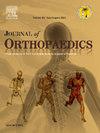在特定患者队列中进行前交叉韧带初次修复: 一项前瞻性单一队列研究
IF 1.5
Q3 ORTHOPEDICS
引用次数: 0
摘要
背景前交叉韧带(ACL)撕裂是一种常见的膝关节损伤,尤其是在运动量大的人群中。虽然前交叉韧带重建术(ACL-R)是标准治疗方法,但它有明显的局限性。目的 通过严格的纳入和排除标准,评估选定患者队列中前交叉韧带初次修复的效果,重点关注手术的存活率、功能效果以及影响成功率的因素。患者年龄在50岁或以下,近期受过前交叉韧带损伤,既往未接受过膝关节手术或多韧带损伤。主要结果是两年后修复的存活率(以翻修率衡量),以及使用Lysholm膝关节评分、Tegner活动量表和Lachmeter稳定性测量结果评估的功能结果。结果54名患者完成了至少三年的随访(平均49.6个月)。总体成功率为82.2%,其中谢尔曼1型撕裂的失败率明显低于2型(4.3%对31.8%)。成功修复的 Lysholm 评分平均为 96 分,Tegner 评分从受伤前的平均 6 分降至 5 分。青少年的失败率最高(50%),而其他年龄组的失败率较高。结论前交叉韧带初次修复对于特定患者,尤其是谢尔曼1型撕裂患者是一种可行的选择。虽然年龄和撕裂类型对治疗效果有很大影响,但该手术的效果很好,成功修复的患者功能评分很高。为了验证这些研究结果并完善患者选择标准,有必要进行更大规模的研究并延长随访时间。前交叉韧带初次修复术为前交叉韧带重建术提供了一种创伤较小的替代方法,并有可能取得类似的效果。本文章由计算机程序翻译,如有差异,请以英文原文为准。
Primary ACL repair in a selected patient cohort: A prospective single cohort study
Background
Anterior cruciate ligament (ACL) tears are common knee injuries, particularly in physically active individuals. While ACL reconstruction (ACL-R) is the standard treatment, it has notable limitations. Recent interest in primary ACL repair offers a potential alternative, especially for specific tear types and patient demographics.
Purpose
To evaluate the outcomes of primary ACL repair in a selected patient cohort with strict inclusion and exclusion criteria, focusing on the survival of the procedure, functional outcomes, and factors influencing success rates.
Methods
This prospective single cohort study included 61 patients who underwent primary ACL repair between June 2016 and June 2022. Patients were 50 years or younger, with recent ACL injuries and no previous knee surgeries or multiligament injuries. The primary outcomes were the survival of the repair beyond two years, measured by revision rates, and functional outcomes assessed using the Lysholm knee score, Tegner activity scale, and Lachmeter stability measurements.
Results
Fifty-four patients completed a minimum follow-up of three years (average 49.6 months). The overall success rate was 82.2 %, with Sherman type 1 tears showing significantly fewer failures compared to type 2 (4.3 % vs. 31.8 %). The mean Lysholm score for successful repairs was 96, and the Tegner score dropped from a pre-injury average of 6 to 5. Adolescents had the highest failure rate (50 %), while other age groups showed better outcomes. The mean side-to-side difference in stability was 1.4 mm, favoring the control side.
Conclusion
Primary ACL repair is a viable option for selected patients, particularly those with Sherman type 1 tears. While age and tear type significantly affect outcomes, the procedure shows promising results with high functional scores in successful repairs. Further research with larger cohorts and extended follow-ups is necessary to validate these findings and refine patient selection criteria. Primary ACL repair offers a less invasive alternative to ACL reconstruction, with potential for comparable outcome.
求助全文
通过发布文献求助,成功后即可免费获取论文全文。
去求助
来源期刊

Journal of orthopaedics
ORTHOPEDICS-
CiteScore
3.50
自引率
6.70%
发文量
202
审稿时长
56 days
期刊介绍:
Journal of Orthopaedics aims to be a leading journal in orthopaedics and contribute towards the improvement of quality of orthopedic health care. The journal publishes original research work and review articles related to different aspects of orthopaedics including Arthroplasty, Arthroscopy, Sports Medicine, Trauma, Spine and Spinal deformities, Pediatric orthopaedics, limb reconstruction procedures, hand surgery, and orthopaedic oncology. It also publishes articles on continuing education, health-related information, case reports and letters to the editor. It is requested to note that the journal has an international readership and all submissions should be aimed at specifying something about the setting in which the work was conducted. Authors must also provide any specific reasons for the research and also provide an elaborate description of the results.
 求助内容:
求助内容: 应助结果提醒方式:
应助结果提醒方式:


